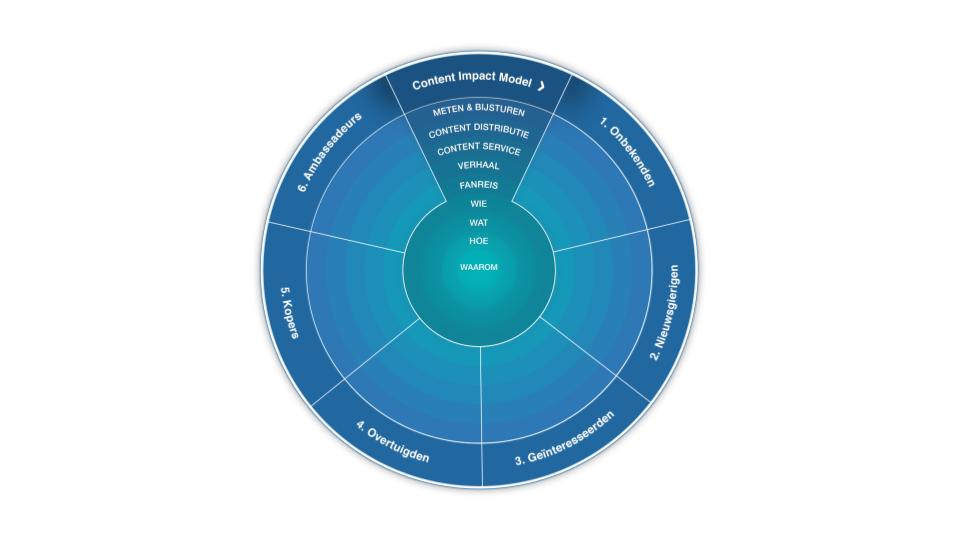This model ensures that content leads to revenue
As an artist, brand or organization, you want to connect with potential followers or customers. Indeed, you depend on them if you want to have any future sales. To do that, you use - if all goes well - content: videos, texts, images, etc. To score with content, two things are important. Those are a digital heartbeat and very relevant content.
From a session I had with my colleague Michiel Schoonhoven of in 2016, a new working model emerged. This model drives the second layer from the framework and provides the execution. Schoonhoven explains how the Content Impact Model helps you generate revenue, cut costs and even develop new revenue models with relevant content.
Building valuable relationships
Schoonhoven has been involved in content marketing for more than a decade. "Actually, this field only really emerged from 2010 and got this name in America, namely by one of the founding fathers, Joe Pulizzi." What is content marketing? "Traditional marketing is primarily based on the 4Ps (product, place, price and promotion), with marketers mostly focusing on campaigns and advertising: buying reach and converting that to sales.
Content marketing is about the whole process involved in building a valuable relationship between an organization and its audience (its fans, customers, prospects, partners and suppliers). You do this by developing and sharing relevant and impactful content (in the form of information, education and inspiration, among other things) at all stages of the relationship. From the very first contact to ambassadorship."
How did your passion for content marketing arise?
"Before I started working as an independent content strategist in 2014, I worked for a long time at a financial advisory organization. Here I was responsible for marketing activities to increase mortgage and insurance sales. Around 2009, I took my first steps in what is now called 'content marketing.'"
"At the time, it didn't feel right to me that we were primarily engaged in 'lead generation' for the sale of financial products and did nothing about the relationship with all those customers who had purchased those products. This triggered me to start developing marketing activities in a different way. In that transition I asked myself the question: what is the higher goal of this financial advisory organization? The answer to that turned out to be: making and keeping people financially healthier."
"Starting in 2010, this resulted in completely new concepts, such as a Financial Fitness Program, Month of Finance and a Financial Check at Life Changes. Programs that were completely content-based and offered people insight into their financial situation. We provided valuable financial tips and a personalized roadmap to healthy financial management. These content programs became a product in their own right, which are still being used today."
"Eventually, an insurance policy, mortgage or other financial product became a means of getting or staying financially 'fitter,' but the financial product was no longer the starting point of marketing activities. With that, we put content very clearly to build a relationship between customers and the financial advisors. Many enthusiastic responses followed, such as: 'finally an organization that doesn't push products, but really helps me with valuable information'. The results were positive as, among other things, a much better relationship developed between advisors and their clients. This new marketing approach gave me so much satisfaction that I started to specialize further on this topic."

Content Impact Model
Exactly this question ("what is our role, who are we?") is still Schoonhoven's starting point when he develops a content strategy for a company. "I have shaped my experiences into a model, which I have fine-tuned further in recent years. In it, the 'why' question is still the starting point of every project we do." You can therefore see this 'Why' at the core of the model.
"Creating and distributing content should always be done with the higher purpose (the 'why') in mind. It must also be fully aligned with the needs of your audience. If content is used solely as a 'sales trick,' then you are not being credible. It starts with figuring out what content really adds value for your audience and how best to share it with them in a rhythm (the digital heartbeat, ed.), so you're not just haphazardly posting something on social media."
"So always ask yourself the question: why would someone spend their precious time following me? For this, it is extremely important to think 'outside-in.'
What do you inspire or inform your followers or fans with? The people who deal with content at our agency are called 'fan experience managers' for a reason: they manage fans' experiences, and not entirely coincidentally, they do so through content."
Three reasons why content pays off
Schoonhoven lists three reasons to start using content today to build valuable relationships with your followers, fans, customers and prospects:
1: Increase your sales
"In this era, it is of utmost importance to think audience first. Build a (digital) relationship with a clearly defined audience first with valuable content. After all, that relationship is what will allow you to generate sales in the long run."
In fact, you should be able to summarize any content strategy into a promise to your audience. A brief example:
"Dear ....,
My goal is to get more people around the world moving to become healthier and more confident. Everything I do enables me to make this happen. If you think this is so important too, then I would like to invite you to join our community. There, members and I share all kinds of experiences, information and tips that help you move more. Our members report that after only 3 months they have started moving 50% more and feel much fitter. And more importantly: because of all the inspiration in the community, they also keep it up easily and don't fall back into old and 'lazy' habits."
If you formulate this promise well and direct it, you will automatically develop content and offer products that are fully in line with it. The content can even be used sustainably, allowing you to develop new revenue models. Consider, for example, access to the community in the form of a monthly subscription, if the content is so valuable that someone is willing to pay for it.
With sustainable content, you also avoid just passing by in fleeting social media timelines, where people are busy scrolling and occasionally bothering to move their thumb to the 'like' button. With your content, let them continuously have a 'stop, I have to check this out because I always find this cool/interesting' moment! In doing so, you work to grow sales and you do it efficiently. Having your own content platform that you have control over is also very important for this. Don't become too dependent on "borrowed" channels like Facebook!
2: Cut costs
If you don't share relevant content with your followers, you become less and less visible on their timelines. "For example, Facebook announced on Jan. 13, 2018, that channels on which there is little or no dialogue or interaction will be considered irrelevant. That content is going to be shown less and less in users' timelines."
"If you are no longer visible in someone's timeline, then you have to start reaching them in another way, for example by advertising. That is a costly and unsustainable operation. After all, you don't build scalable content, so you have to continually re-spend ad budgets. However, content can be used for all forms of information, at all stages of the relationship with your audience.
Consider, for example, answering questions: instead of having to continuously answer the same kinds of questions via direct message or by mail, you can develop content and a process that answers fans' questions directly and automatically. For example, via a chatbot, as Hardwell (see: chapter 30) does. With that, information becomes truly scalable, instantly available to your fans and you save enormously on costs."
3: Develop new revenue models
"If you see content as an integral part of the business model, it is possible to develop numerous new revenue models for it. The starting point for this is having or building a clearly defined audience. Then you can introduce revenue models, where your audience pays for the use of the content, for example through a subscription. Or you let other parties pay to have you communicate with your audience via e-mail, your social media, a webinar, etc.."
Schoonhoven finds the following more urgent: many products are becoming commodities and easily copied. "A very important part of your distinctiveness and value is increasingly going to lie in the audience built up and the relationship people have with you. If very relevant content is shared, where you really impact your audience, then a valuable relationship with your audience is created.
If you use content only to sell a product or service, you are missing a huge opportunity to add value and have a competitive advantage. Chances are your competitors are jumping into that gap. Without relevant content and a valuable relationship with your audience, you're going to lose out in the competition in the long run."
Relationship Economics
Part of the Content Impact Model is your digital heartbeat. This is the rhythm in which you share content (at regular intervals), on the channels where your audience expects you and (if all goes well) looks forward to you. Learn more about this in this post.
In today's (digital) economy, companies are increasingly dependent on the relationships they build with fans and customers. They build those relationships by sharing content (and answering timely questions from customers or fans). Getting by in this new economy requires a true digital vision, which lets you work with the Business Acceleration Roadmap and Framework. The latter lets the organization take off into the digital realm. However, a digital vision starts with setting goals to the digital transformation.
One of these objectives is to improve brand reputation. This is the approach to marketing (and key milestones), which you should be able to summarize as a graphic overview on one A4. This document should show a rhythm in an organization's communication. In addition, content content also affects this objective. In other words, the Content Impact Model helps you work on the brand reputation of your artist, organization or brand. If you don't use the model, chances are you're not going to make it in the relationship economy.
Strategy
Schoonhoven recommends using the Content Impact Model because it forms the basis for developing the Content Impact Strategy. "This makes it very clear which content is relevant to your audience and through which channels you can best distribute the content. It is important to take into account the 'fan journey' of your audience. By this I mean the different stages someone goes through from the moment he or she doesn't know you yet to the moment he has even become a fan or ambassador of your company."
"The phases of the fan journey are: awareness, interest, consideration, decision, purchase and experience. Each of these phases requires different content and uses different channels. For example, if you visit a festival (and are in the 'experienced' phase), then it makes sense that in this phase you are willing to leave a review or share your own experiences via social media. You also exhibit different search behavior than someone who has yet to orient themselves to a festival. If you went to the festival in 2017 and loved it, chances are you will return in 2018 - and thus search for the date for the same festival in 2018. Someone who has never been to the festival is often looking for more and different information about the festival."
Below is a brief example of the fan journey, worked out as part of the Content Impact Model. Here the time (the step in the buying process) and the process (what do I do with what content) are clearly opposite each other in a diagram. You'll also see a diagram showing what type of content to post for each week. As you can see, more information streams become relevant once more time has passed.
Sales curve
Every organization, brand or festival has a sales curve. It is pointless to get people to sell a ticket (or product) in week four (during the orientation phase), because they are still orienting themselves. The Content Impact Model is therefore a good indication of your sales curve, which helps you deploy marketing budgets even smarter.
Once you've developed a Content Impact Strategy, you can get started with the Content Impact Roadmap. That's the translation from strategy to execution - and it's in a diagram that shows you when to publish what type of content on what channel. It also shows which content is relevant to publish. For example: news items, columns, photos, videos, music (demos and releases), podcasts and streaming (relevance). This is the daily translation of your content ambitions (the Content Impact Model) and reality (your digital heartbeat).
Conclusion
Those who measure know whether their content efforts are paying off. Therefore, a number of analyses must take place. The most important analysis involved is IPM. That is the number of interactions per thousand fans. The IPM formula is: ((Number of comments + likes) / number of posts)) / #fans) = IPM. This number expresses how many interactions take place around your website or social channels. The higher your IPM, the more relevant your content is likely to be to your target audience.
Above all, organizations, brands and artists who want to make content really work for them need to be proactive with content. That means not sharing a post on their social media channels only once they win an award. Set up a good Content Impact Roadmap in advance, showing a healthy rhythm. Also determine in advance what the IPMs of the various channels are. If you stick to these principles, chances are you will score with content.
Decide how often (rhythm) you want to reveal content (consistency) and then keep it up (discipline). Therein lies the real challenge: This combination of rhythm, consistency and discipline is often underestimated. If you meet - and overcome - that challenge, you can ensure that content contributes to the growth of your business, provides cost savings and even creates new business models. Above all, Schoonhoven's warning is urgent: "if you are unable to build a valuable digital relationship with your audience through relevant content, chances are you will lose the competition."
* This article previously appeared as a chapter in the book "Digital Capability" and has been edited for this blog.




